Using Multirotors for a New Video Angle
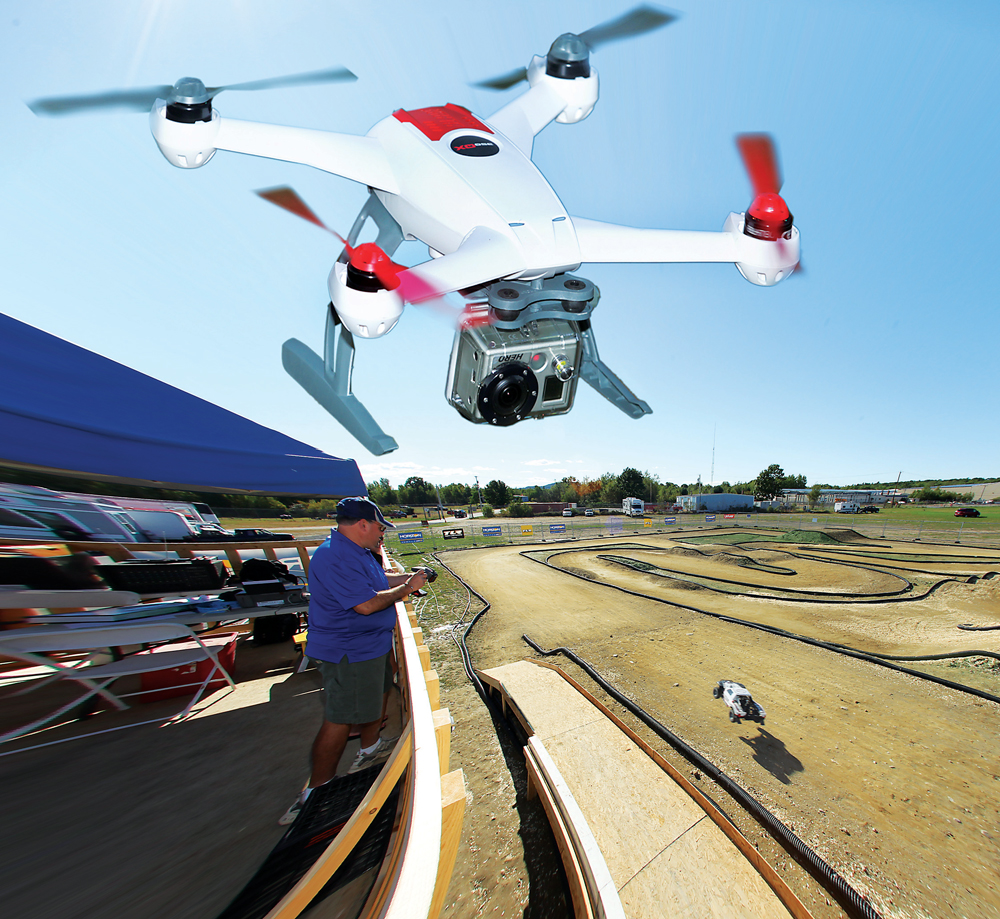
Words: Erick Royer
Photos: Walter Sidas
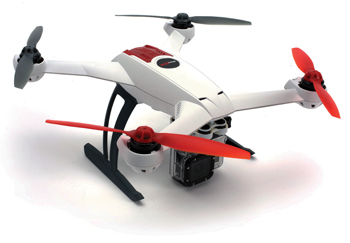
Race action can be intense and thrilling for spectators to watch, but just like with NASCAR and other full-scale racing events, the best action is captured from the air. Shooting photos and video from a camera directly above the race allows you to take in everything that is going on in one view, especially if your aerial camera is equipped with a wide-angle lens. From above you can see who is leading the race and exactly how far ahead they are, crashes look different and vehicles soaring off jumps have a completely different perspective. Additionally, with a properly set-up aerial camera ship and a stabilized gimbal for the camera, you can chase a specific car and capture footage like they do with full-scale, using million-dollar helicopters and camera rigs…and you can do it for a matter of a few hundred dollars. We will show you how.
The first and most important thing you need when setting out to cover racing action from the sky is permission. Yes, you need to make sure that the race host and drivers are okay with you flying over the track. Even though the machines are stable and have GPS to aid the pilot in keeping them in place, there is always the chance that something can go wrong. The marshals especially need to be aware, since they are out on the track. Another thing to be aware of is the prop wash will likely stir up dust on and around the track. So as long as everyone is aware and okay with you capturing aerial footage of the race, then the next step is choosing a multirotor and camera system.
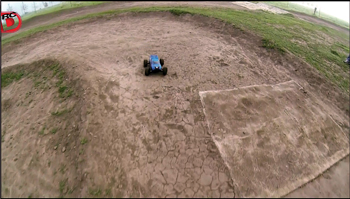
EXPERIENCE
You have a lot of options when choosing a multirotor. There are a few things to consider when making your selection. Experience is the first thing we will look at. If you are new to flying multicopters, then I suggest you look for a ready-to-fly machine such as the Blade 350 QX or the DJI Phantom line of quadcopters. These machines come with everything you need to get airborne in the box including battery, charger, transmitter and provisions for mounting a GoPro camera. Both machines have GPS and pilot assistance technology, which is designed to keep the ship in space where you put it. They also have self-leveling so when you move around the sky and take your hands off the sticks, they will automatically maintain a level hover. Having flown both the Blade 350 QX and the DJI Phantom, I can honestly say that either quad is a good choice even if you have never flown before.
That brings me back to experience. If you are new to flying multirotors then you have no business flying over a race with people around. You need to spend some time to get really good at flying the machine. Just because they have safety and pilot assistance features does not mean they fly themselves, and in the event that something goes wrong, someone can get seriously hurt. I suggest that you fly many battery packs over the race track when no one is there so you can get used to where everything is, like the driver stand, trees, fences, etc. It is also a good idea to fly around the track as if you are a car floating in the air. You want to get really comfortable with all aspects of flying the copter in all directions, including when it is coming toward you, at which point the controls are reversed. Once you are comfortable and can quickly and safely react to changes in the wind and obstacles then you can move on to live race coverage.
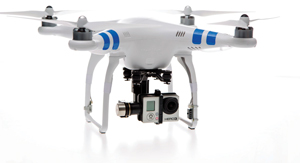
EQUIPMENT
As I previously mentioned, the Blade 350 QX and DJI Phantom are two good machines for capturing video from above a race. They both come with fixed mounts for the GoPro camera. This set-up is good for getting basic footage but there are a few things that you need to keep in mind. First, you need to adjust the angle of the camera prior to the flight, so you need to determine if you want to record the video out in front of you or directly below your machine. I recommend angling the camera towards the ground and flying higher if you are new to shooting video at races. This will allow you capture most of the track from a center location and in the event something goes wrong with the ship, you have some time to get out of harm’s way. Positioning the camera for shooting in front of the copter will require you to fly around more and at a lower altitude.
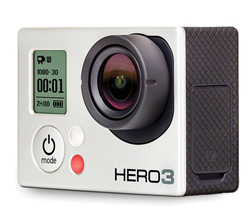
The second thing to think about is video quality. Even though they have rubber dampeners on the camera mounts, the footage is still going to be affected by the motion of the quad. So wind gusts and rapid pilot movements will make the video look more like a roller coaster. To solve this problem you will need to install a 2-axis brushless gimbal on the machine. A brushless gimbal will work to keep the camera level with the horizon no matter what the attitude of the multirotor is. This will give you a more professional, very stable video quality that your viewers will thank you for. Another feature that you gain with a gimbal is the ability to vary the pitch of the camera while in flight from your transmitter. So you can shoot out in front and then angle the camera down to capture direct overhead shots. Setting this feature up on the Blade or Phantom is not plug-and-play and will require some minor technical skills, which are outside the scope of this article, but if you search on Google for your particular multirotor and gimbal you will find tons of help.
The type of shooting that you want to do is also something to consider when choosing a machine. If you are looking to shoot from fixed positions around the track then a quadcopter is a good choice. However, if you are looking to follow a car all the way around or want to get a lot of motion shots, I personally love to use a tricopter. A tricopter flies like a hybrid between a quadcopter and an airplane. The ship can bank and swoop in a more fluid manner than a quad, giving you some really interesting and dramatic video footage. My aerial machine that I use is a HobbyKing X900 tricopter. It is nice because it is foldable, making it easy to transport, the front props are far apart so they don’t get in the way of the video and it is a very inexpensive machine, costing less than $200 ready-to-fly (minus the camera). Tricopters do require more skill than a quad, but the resulting video can be amazing.
The last thing that you need to consider is an FPV setup. FPV stands for “first person view” which basically allows the pilot to see what the camera sees from the aircraft. There are two main types of FPV setups; video goggles or a monitor. For capturing video at a race where people are around, I would not recommend using FPV goggles because they limit your visibility to only what the camera sees and it is easy to lose spacial awareness. The best set-up is to use a video monitor that you either have mounted on a transmitter holder in front of you or positioned on a tripod. That way you can fly visually (or line of sight) but refer to the monitor to frame your shots.
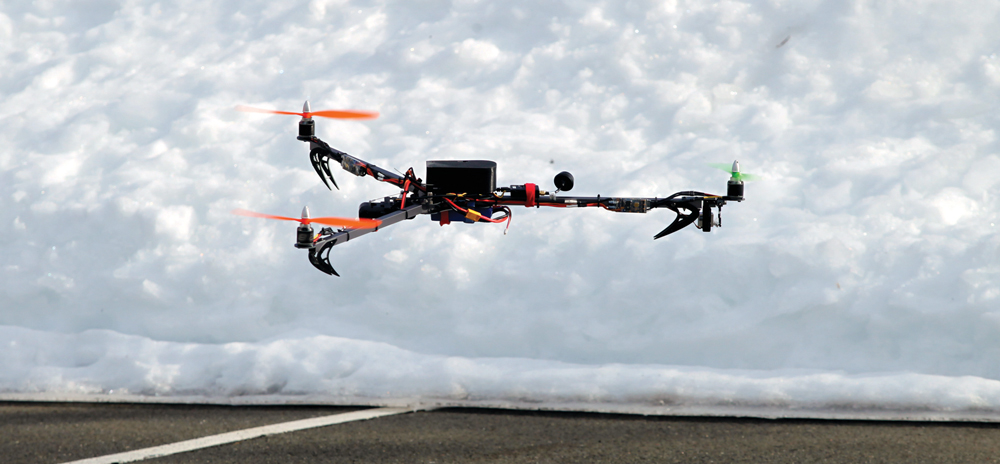
When choosing an FPV system, the most important factor is the frequency of which your video transmitter will operate. FPV systems transmit on several different frequencies depending on the application. Since most, if not all, RC transmitters that the drivers use to operate their car are 2.4GHz, you want to make sure you don’t use that for your video transmission or you can have a lot of unhappy drivers on your hands if there is any interference. Distance is not an issue since you will be within a hundred feet from the track, so lower frequencies are not necessary. The 5.8GHz band is perfect for this type of video production. There are a lot of systems readily available that run on 5.8 and they are very affordable.
CAMERA OPTIONS
Undoubtedly, the most popular camera on the market in the “action cam” line is the GoPro Hero 3. It is also the camera that has the most accessories, like gimbals and connectivity options for video transmitters. The downside of the GoPro is that they are not cheap. Again if you are an experienced pilot, the GoPro is an excellent choice. However, races will stir up dust debris which is not always conducive to expensive camera systems. There are other inexpensive cameras on the market that still shoot in HD quality which cost considerably less. The Mobius Action Cam is one model that comes to mind and which we have used successfully. This camera is available from many sources including HobbyKing.com for less than $70. It offers a video out so you can still use FPV but since it does not cost as much you don’t have as much to worry about. The main issue you will have with the Mobius and other less expensive cameras is that it will be hard, or impossible to find a commercially-available gimbal to fit one. Of course if you are handy with aluminum, own a hobby CNC or have access to a 3D printer you might be able to easily fashion a mount to work on an existing GoPro gimbal. Of course, if you don’t want a gimbal, then you can simply attach it to your multirotor and go fly.

WRAP UP
It is always great to see things we love from new perspectives and catching the action of a race from above can produce some amazing video footage. Quadcopters like the Blade 350 QX and the DJI Phantom make it easy for just about anyone to build confident flying skills quickly. Practice and trust in your skills and machine are paramount prior to flying around other people or expensive items like radio control cars. Once you master the machine and learn how to frame your video shots, you will be rewarded with some pretty amazing race footage that could only be seen if you were a bird.
LINKS
Blade, bladehelis.com
DJI Innovations, dji.com
GoPro, gopro.com
HobbyKing, hobbyking.com
 RC Driver The Best In RC Car & Truck News, Reviews & Video
RC Driver The Best In RC Car & Truck News, Reviews & Video 







